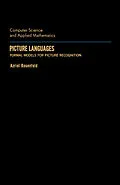Computer Science and Applied Mathematics: Picture Languages: Formal Models for Picture Recognition treats pictorial pattern recognition from the formal standpoint of automata theory.
This book emphasizes the capabilities and relative efficiencies of two types of automata-array automata and cellular array automata, with respect to various array recognition tasks. The array automata are simple processors that perform sequences of operations on arrays, while the cellular array automata are arrays of processors that operate on pictures in a highly parallel fashion, one processor per picture element.
This compilation also reviews a collection of results on two-dimensional sequential and parallel array acceptors. Some of the analogous one-dimensional results and array grammars and their relation to acceptors are likewise covered in this text.
This publication is suitable for researchers, professionals, and specialists interested in pattern recognition and automata theory.
Autorentext
The late Azriel Rosenfeld was a tenured research professor, a distinguished university professor, and the Founding Director of the Center for Automation Research at the University of Maryland in College Park, where he also held affiliate professorships in the departments of computer science, electrical engineering, and psychology. Dr. Rosenfeld was widely regarded as the leading researcher in the world in the field of computer image analysis. Over a period of nearly 40 years, he made fundamental and pioneering contributions to nearly every area of that field. He wrote the first textbook in the field, was founding editor of its first journal, and was co-chairman of its first international conference. He published over 30 books and over 600 book chapters and journal articles, and directed nearly 60 Ph.D. dissertations. Dr. Rosenfeld's research on digital image analysis specifically on digital geometry and topology and the accurate measurement of statistical features of digital images in the 1960s and 1970s formed the foundation for a generation of industrial vision inspection systems that have found widespread applications from the automotive to the electronics industry. He was a Fellow of the IEEE and the Washington Academy of Sciences; a Founding Fellow of the AAAI, the ACM, and the IAPR. Among his numerous awards and honors are the IEEE's Emanuel Piore Award, its Third Millennium Medal, and its Distinguished Service Award for Lifetime Achievement in Computer Vision and Pattern Recognition.
Inhalt
Acknowledgments
Automaton Nomenclature
Chapter 1 Introduction
1.1 Foreword on Picture Recognition
1.2 Foreword on Automata Theory
1.3 Scope of This Book
References
Chapter 2 Digital Geometry
2.1 Introduction
2.2 Basic Concepts
2.3 Arcs and Curves
2.4 The Jordan Curve Theorem
2.5 Simple Points
2.6 Borders, Adjacency, and Surroundedness
2.7 Area, Perimeter, and Genus
2.8 Distance and Diameter
2.9 Geodesics
2.10 Concluding Remarks
References
Chapter 3 String Acceptors
3.1 Introduction
3.2 Automata and Acceptors
3.3 The Language Hierarchy
3.4 Cellular Acceptors
3.5 Closure Properties
References
Chapter 4 Sequential Array Acceptors
4.1 Introduction
4.2 Array Automata and Acceptors
4.3 Rectangular Array Acceptors
4.4 Connected Array Acceptors
4.5 Closure Properties
References
Chapter 5 Cellular Array Acceptors
5.1 Introduction
5.2 Cellular Array Automata and Acceptors
5.3 Rectangular Cellular Acceptors
5.4 Connected Cellular Acceptors
5.5 Speed Comparisons
References
Chapter 6 Pyramid Cellular Acceptors
6.1 Introduction
6.2 Cellular Pyramids
6.3 Local Property Detection and Counting
6.4 Comparisons with Other Types of Acceptors
6.5 Other UPCA Languages
References
Chapter 7 Special Types of Acceptors
7.1 Introduction
7.2 Pebble Acceptors
7.3 Pushdown Acceptors
7.4 Parallel/Sequential Acceptors
References
Chapter 8 Grammars
8.1 String Grammars
8.2 Matrix Grammars
8.3 Array Grammars
References
Index
